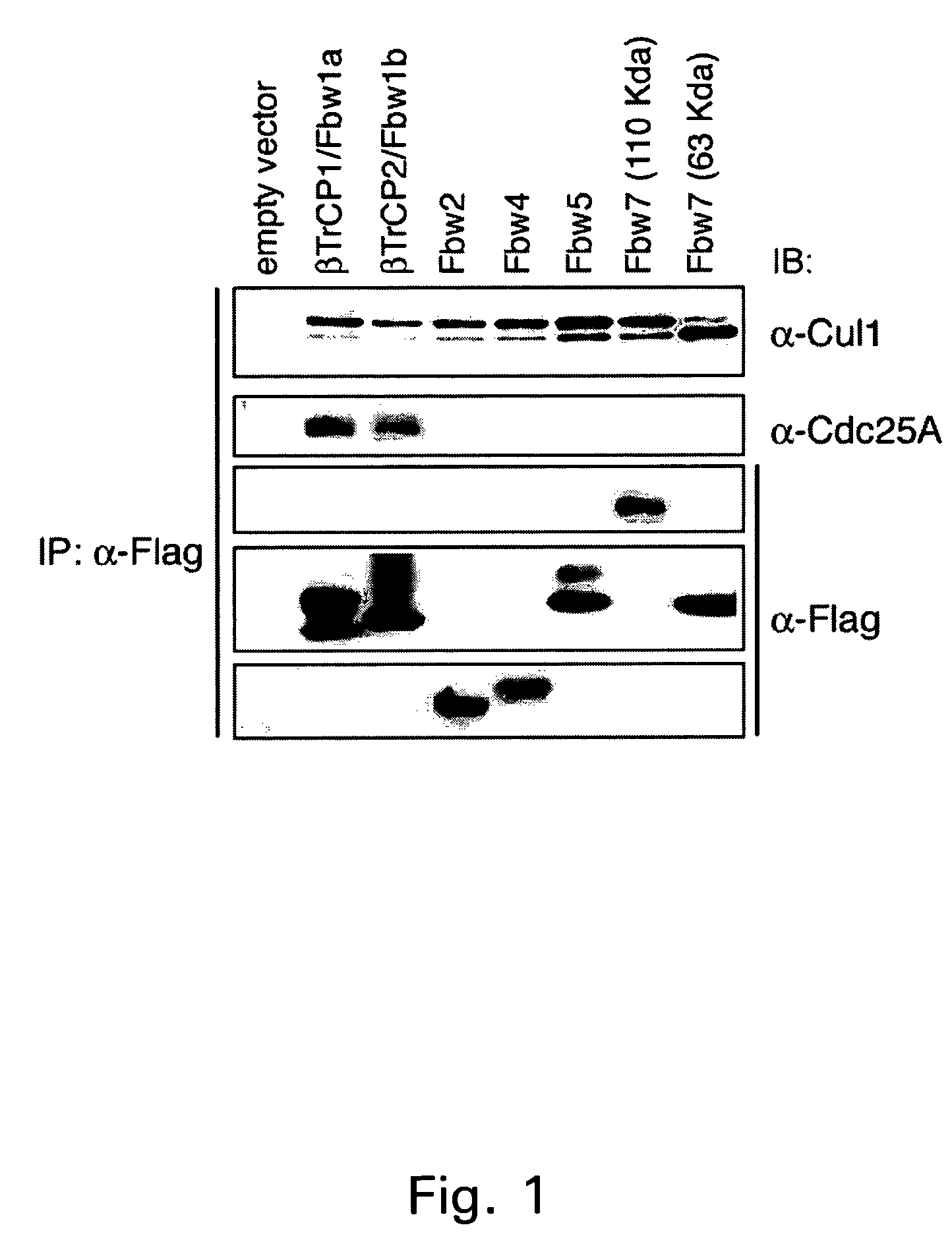Methods to identify compounds useful for tumor sensitization to DNA damage
a dna-damage, tumor-specific, compound technology, applied in the direction of instruments, peptide/protein ingredients, drug compositions, etc., can solve the problem that the f-box protein specifically responsible for cdc25a degradation has not been identified
- Summary
- Abstract
- Description
- Claims
- Application Information
AI Technical Summary
Benefits of technology
Problems solved by technology
Method used
Image
Examples
example 1
Screening for F-Box Proteins Interacting with Cdc25A
[0152]It was previously established that Cdc25A is in complex with Cul1 and Skp1 (Donzelli, M. et al., Embo J 21, 4875-84 (2002)). In this Example, the possible involvement of SCF in the degradation of Cdc25A was investigated.
[0153]A number of human F-box proteins, including β-TrCP1 (Fbw1a), β-TrCP2 (Fbw1b), Fbw2, Fbw4, Fbw5, Fbw7 (110 kD), Fbw7 (63 kD), Skp2 and Fbl3 were screened for interaction with Cdc25A (Cenciarelli et al., Curr Biol, 1999;9:1177-9; Kipreos & Pagano, Genome Biol 1, REVIEWS3002 (2000)). As a control, we assessed that the Cul1 subunit was complexed to all the F-box proteins tested.
[0154]It was observed that β-TrCP1 and β-TrCP2 were the only F-box proteins among those tested which were able to interact with Cdc25A in vivo (FIG. 1). In a parallel experiment, it was shown that overexpressed Cdc25A co-precipitates with β-TrCP1 and β-TrCP2, but not with Skp2 and Fbw7 (FIG. 2). Interestingly, the Cdc25A co-precipitat...
example 2
Motifs Contributing to Cdc25A / β-TrCP Interaction
[0155]The Cdc25A amino acid sequence contains a motif, DSGXXXXS (SEQ ID NO:20), similar to the DSGXXS (SEQ ID NO:21) or DSGXXXS (SEQ ID NO:22) present in known protein substrates of the SCFβ-TrCP complex (FIG. 4; Yaron, A. et al., Nature, 1998;396: 590-4; Winston, J. T. et al., Genes Dev, 1999;13:270-83; Lassot, I. et al., Mol Cell Biol, 2001;21:2192-202; and Lang, V. et al., Mol Cell Biol, 2003;23:402-13). Phosphorylation at both serine residues is required for beta-TrCP binding and for subsequent substrate degradation to occur (Winston, J. T. et al., Genes Dev, 1999;13:270-83; Liu, C. et al., Cell, 2002;108:837-47).
[0156]To assess the contribution of this motif to the interaction, both Ser82 and Ser88 were mutated to Ala to generate a mutant called DSG2x, and Ser82, Ser88, and Ser79 were mutated to Ala to produce a mutant called DSG3x (FIG. 4). It was then tested whether the mutated proteins would interact with beta-TrCP in transfect...
example 3
Effect of β-TrCP Silencing on Cdc25A Accumulation
[0161]To conclusively assess the role of β-TrCP proteins in controlling the subcellular abundance of Cdc25A, a series of siRNA experiments were performed. Briefly, asynchronously growing cells were transiently transfected with a small interfering RNA oligonucleotide targeting both beta-TrCPI and beta-TrCP2 genes and analyzed for levels of Cdc25A at steady state. As shown in FIG. 11, efficient silencing of β-TrCP1 and β-TrCP2 genes caused a substantial accumulation of Cdc25A as compared to mock-transfected cells. No significant changes were observed on Cdc25A mRNA level (FIG. 12).
[0162]With this data at hand, the consequences of silencing β-TrCP gene expression at various stages of the cell cycle were tested. Mock or β-TrCP1 / 2 siRNA-transfected cells were synchronized by double-thymidine treatment, released from G1 / S arrest in the presence of nocodazole and followed over time for Cdc25A accumulation. β-TrCP1 / 2 siRNA-treated cells progr...
PUM
| Property | Measurement | Unit |
|---|---|---|
| melting temperature | aaaaa | aaaaa |
| Tm | aaaaa | aaaaa |
| Tm | aaaaa | aaaaa |
Abstract
Description
Claims
Application Information
 Login to View More
Login to View More - R&D
- Intellectual Property
- Life Sciences
- Materials
- Tech Scout
- Unparalleled Data Quality
- Higher Quality Content
- 60% Fewer Hallucinations
Browse by: Latest US Patents, China's latest patents, Technical Efficacy Thesaurus, Application Domain, Technology Topic, Popular Technical Reports.
© 2025 PatSnap. All rights reserved.Legal|Privacy policy|Modern Slavery Act Transparency Statement|Sitemap|About US| Contact US: help@patsnap.com



